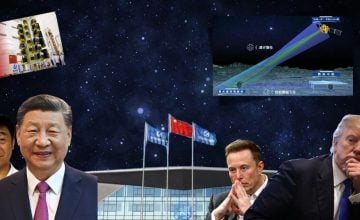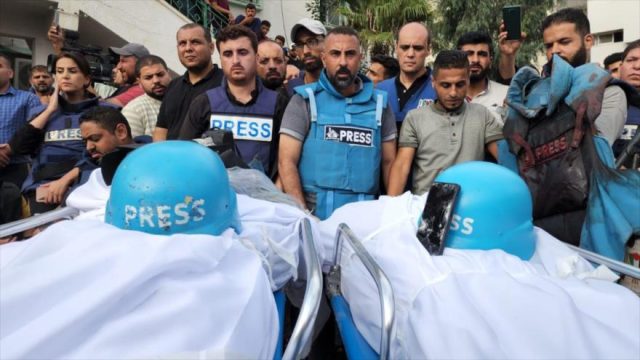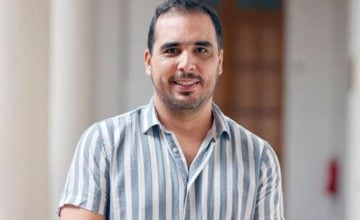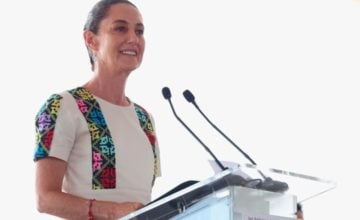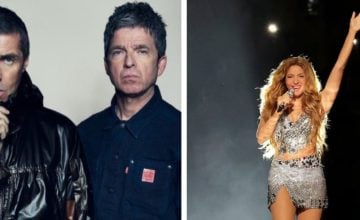The historic demands of the population in Colombia, neglected for years by the «guerrilla threat», emerge in a country that has signed a peace treaty. Inequality and poverty, exacerbated by the pandemic, now become the «common enemy».
Not even the pandemic, which accumulates more than 76,000 deaths and almost 3 million infections, has been able to stop popular discontent. The days of protests against the government of Iván Duque began in 2019, continued in 2020 (briefly interrupted by confinements and quarantines) and have intensified today, explains journalist Nazareth Balbás in an RT report. In that period, Colombia’s indicators – considered an «example of success» nation by the Organization for Economic Cooperation and Development (OECD) – have only gotten worse, said Balbás.
Last week, official figures revealed that poverty in Colombia reaches 21 million people, that is, 42% of the country. The number of displaced persons, which in 2016 was 7.2 million, has risen to almost 8 million; the systematic murder of social leaders and ex-guerrilla fighters persists and, only so far in 2021, they have killed 79. In this context, the proposal for a tax reform that would especially affect the poorest was the missing spark.
«People got tired and took to the streets. The tax reform proposed by the Government was nothing more than the spark that triggered needs and demands that have a much deeper historical root”, summarizes researcher Richard Tamayo, doctor of law from the University of Rosario and a teacher in Philosophy of the Javeriana University. But why are they now gaining more visibility?
For the political scientist and analyst Andrea Salazar, who accompanied the first conversations between the Government and the extinct FARC guerrilla, there is a key point: «The reality is that having signed a peace agreement, with all the difficulties of implementation, What it has done, precisely, is that now we are left without an excuse to face our historical conflicts. In addition, these are no longer processed in the jungle, in the mountains, but are transferred to much more urban settings. The problem is that, both in speech and in action, the Executive’s response remains anchored in a warmongering logic that already has a fatal toll that proves it: 37 deaths, almost all allegedly at the hands of the public force».
What happens in Colombia?
Colombia is dragging a structural conflict that has to do with land tenure. The struggles for territory, which caused the violent dispossession of many for the wealth of a few, were the germ of a war almost six decades ago in which various armed actors took part, and which was later aggravated by the dynamics of «drug trafficking, mining and energy exploitation, agro-industrial models and criminal alliances between paramilitaries, politicians, public servants, local economic and business elites, and drug traffickers”, as documented by the National Center for Historical Memory.
In 2016, with the agreement between the Government and the FARC, peace was declared. However, that pact implied a difficult implementation that, for now, is still pending. The assassinations of ex-combatants, the birth of new criminal structures that seek to take control of the areas left by the demobilized guerrillas, the permanence of paramilitary groups and the consolidation of drug trafficking – which expands their presence in Colombian territory – add to the ‘silent’ violence of economic, social and economic inequality.
In that tinderbox, Duque has not only put projects such as the failed tax reform on the table, but also promoted a decree that opens the doors for the fumigation of coca crops with glyphosate, encouraged mining and energy concessions in conflict territories, promoted a questioned change to the pension system and, ultimately, dictating a series of unpopular measures that push the population to the streets.
For Tamayo, instead of attending to the historical demands and the emerging poverty due to the pandemic, the Duque Administration «the only thing that is doing is to alleviate the pockets of the banks and arm the country even more», since the Colombian Government announced the possible purchase of planes and weapons for 4,000 million dollars, almost 60% of what it intended to collect with the tax reform (6,400 million dollars).
The analysts consulted by RT point to the «disconnection» of the Government with the current reality of the country, an issue that for them is evident in the priorities established by Duque: national security and macro finance. “They believe that the banks can save (the country), but they have not realized that it is the people who are dying of hunger, that these people demand urgent and timely attention», said Tamayo.
«Vandals and terrorists»
From the institutional framework, the government’s message insists on linking social protest with the discourse of war. Thus, the Colombian Defense Minister, Diego Molano, has called the protesters «terrorists» and has assured that they have links with the dissidents of the ELN and the FARC. And that is not free.
«Colombia is a country that has historically stigmatized social mobilization and protest», says Salazar. In 2019, the massive marches that were seen in the streets to demand the effective implementation of the peace agreement, attention to the needs of rural environments and a reform of justice, were answered with a heavy hand. After the death of several protesters, the Government promised a dialogue table for March 2020 which, with the arrival of the pandemic, was put on hold. In September of last year, the murder of Javier Ordóñez at the hands of a police officer fueled anger and the street flared up again. The balance of those protests were13 dead.
On that occasion, the State’s response involved the use of a repeated strategy of blaming Venezuela and the «Bolivarian breezes» for having encouraged the protests, as if in Colombia there were no legitimate and real reasons to justify the mobilization. That stigmatization has now been repeated again. In addition to linking the marches with the guerrillas, the government also intends to hold Caracas accountable.
Tamayo warns about the danger that State institutions are pointing out the protesters as «terrorists» and «vandals», in a country where the media repeat the official discourse «generating a whole environment of public opinion that can justify the deaths of citizens». This week, on social networks, the researcher and university professor alluded to a tweet by former president Álvaro Uribe, in which he referred to a «dissipated molecular revolution».
The concept, which appeared to stem from a conspiracy theory, was attributed to Chilean neo-Nazi Alexis López. According to this thesis, «the demonstrations are nothing more than acts of vandalism that are aimed at destabilizing the State, and therefore, they must be dealt militarily», explains Tamayo.
«Our concern is that not only the Government of Colombia is consulting with this type of neo-Nazi leaders, but this is already being reflected in the way in which the protests are being dealt with, which are not seen as a problem of (social) rights, but rather of national security. In the cities, it has been seen that the demonstrations are confronted with weapons of a lethal nature, that is, the public force does not seek to «neutralize» the alleged vandals, but to eliminate them».
This week, López’s video while giving a lecture at the Nueva Granada Military University was widely debated on social media. «The Ministry of Defense has been in charge of training the military within the guidelines of that doctrine and what these people are doing, by spreading hate speech, should be penalized,» says Tamayo.
For him, the training of the Army in doctrines that justify extermination can only lead to a «massacre by the State». The concern grows even more if – as has been requested by some factors allied to the Government – the State of Internal Commotion is decreed, which empowers the president to suspend guarantees throughout the country.
Tamayo explains that «the doctrine of the‘ dissipated molecular revolution makes the State of siege the most desirable in order to carry out the necessary policies to avoid what they call‘ the prostration of the State to the radical left ’. If it is finally approved, the only thing that can be expected is a worsening of the (social and political) conditions and an unprecedented humanitarian crisis in our country».
Although it may seem unlikely, in Colombia, exterminations have already been committed that for years were buried under official justification. Among those, the murder of more than 4,000 members of the leftist Patriotic Union (UP); or the «false positives» policy, which allowed civilians to be presented by the Army as «casualties in combat», disguising them as guerrillas.
The conflict is not far away
In the last week, in addition to the scenes of the public force shooting, detaining and beating protesters, acts of vandalism have also been observed by the participants in the protests, burning of police stations and blocking of public roads, something that the Government has not hesitated to describe as «terrorism».
But the indignation with which the Executive condemns the destruction of public property and the attack on police officers has not been the same when referring to the fatal victims, who are almost entirely civilians. In addition, Duque called this week for a new dialogue and instead of first summoning the representatives of the National Strike, he decided to start with the governmental institutions, something that has not been well seen by the protagonists of the protest.
On the other hand, Salazar emphasizes the fact that the demonstrations take place in the last year of Duque’s government, something that makes them “a great breeding ground for many interests, from all corners, to take advantage of the social mobilization. even misrepresent what is happening». For the researcher, the repressive response of Uribism and the reaction of the left, leave «little room for action» for society to escape polarization.
In the midst of that outrage, the networks burst in like amplifiers. Although Salazar acknowledges that these platforms have served to make historically silenced claims visible, she also believes that the fragmented narrative causes reactions to be volatile and analyses scarce. «I think we are not fully aware of how we read the information we are seeing, how we digest it, so it is very easy to fall into extremism and fanaticism without making more judicious readings».
The Colombian conflict, however, is not just a matter of social media. For Professor Tamayo, for the first time in decades there is a «democratic solidarity awakening» that has united the most vulnerable communities in the country in the same claim: young people, indigenous people, black communities, peasants. And with a voice that rises closer and closer to the cities.
The approach of the conflict to urban contexts that always felt far from the problems of deep Colombia, has shaken the privileged sectors. «People from the highest strata», Salazar argues, «are beginning to feel uncomfortable because they can already hear the pans, they are already affected by the places where they travel. These groups, who have lived under the logic of stigmatizing the marches, would like the protests to be sterile, organized, not to affect, not to bother, but the social demonstration, by definition, has to bother. I’m not saying that you have to use violence, but you do have to bother in order to generate the necessary wake-up call: a system that no one questions does not need to reinvent itself, improve or transform itself. The elites disconnected from reality can now see that historical conflicts begin to appear in their own streets».
